Harmonic Beamsplitters for Nd:YAG Wavelengths
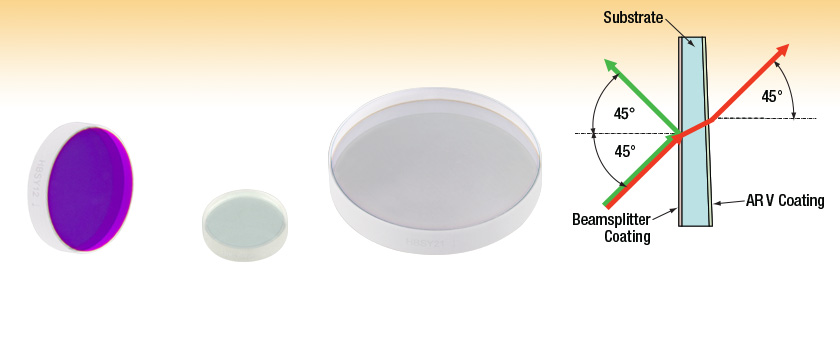
- Split Light in Nd:YAG Applications into Harmonics
- Separate 266 nm, 355 nm, 532 nm, and 1064 nm Light
- UV Fused Silica Substrate with Beamsplitter and AR Coatings
- Available in Ø1/2", Ø1", and Ø2"
HBSY12
Ø1" Beamsplitter Reflects
532 nm and Transmits 1064 nm
HBSY0534
Ø1/2" Beamsplitter Reflects
266 nm and 355 nm, Transmits
532 nm and 1064 nm
HBSY21
Ø2" Beamsplitter Reflects
1064 nm and Transmits 532 nm
Harmonic Beamsplitters Separate
Harmonics of Nd:YAG Lasers (Not to Scale)

Please Wait
| Common Specifications | |
|---|---|
| Clear Aperture | >80% of Diameter |
| Surface Flatness | λ/10 @ 632.8 nm Over Clear Aperture |
| Surface Quality | 10-5 Scratch-Dig |
| Thickness Tolerance | ±0.40 mm |
| Diameter Tolerance | +0.00 mm/-0.20 mm |
| Wedge Angle | 30 arcmin |
| Wedge Tolerance | ±10 arcmin |
| AOIa | 45° |
| Substrate | Fused Silica |
Features
- Four Wavelength Configurations Designed for Nd:YAG Applications
- 1064 nm Reflected, 532 nm Transmitted
- 532 nm Reflected, 1064 nm Transmitted
- 355 nm Reflected, 532 and 1064 nm Transmitted
- 266 nm and 355 nm Reflected, 532 and 1064 nm Transmitted
- Beamsplitter Coating on Front Surface
- Back Surface AR V-Coated at Wavelengths of Transmitted Light
- High Reflectance for Both S- and P-Polarized Light (See the Graphs Below)
- UV Fused Silica Substrate Available in Ø1/2", Ø1", or Ø2" Sizes
Thorlabs' Harmonic Beamsplitters, also known as harmonic separators, are designed to separate the harmonics of light from Nd:YAG laser sources and are available in four wavelength configurations (see the table below for available options).
The reflective beamsplitter coating is applied to the front surface of the UV fused silica substrate, while the back surface is antireflection (AR) V-coated for the transmitted wavelength. Both coatings are optimized for a 45° angle of incidence (AOI). The edge of each beamsplitter is engraved with the part number and an arrow marking the recommended propagation direction (see the drawing to the lower right), though it is also possible to reverse the propogation direction of the beams incident on each beamspltiter to combine light instead of separating it.
The AR V-coated back surface helps reduce unwanted interference effects (e.g., ghost images) caused by the interaction of light reflected from the front and back surfaces of the optic. Approximately 4% of the light incident at 45° on an uncoated substrate will be reflected; by applying an AR coating to the back side of the beamsplitter, this percentage is reduced to an average of less than 1% over the entire operating range of the coating. In addition to this feature, each beamsplitter has a 30 arcmin wedge; therefore, the fraction of light that does get reflected from this AR V-coated surface will diverge.
Thorlabs also offers a wide selection of dichroic mirrors and cube and plate beamsplitters. Mounted and unmounted beamsplitting cubes for high-power applications at popular laser lines are also available.
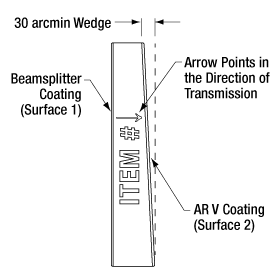
Not to Scale
| Damage Threshold Specifications | ||
|---|---|---|
| Item # | Damage Threshold | |
| HBSY051 HBSY11 HBSY21 |
CW | 250 W/cm (532 nm, Ø0.684 mm) |
| Pulsed | 5 J/cm2 (532 nm, Ø0.279 mm, 10 ns, 10 Hz) 5 J/cm2 (1064 nm, Ø0.31 mm, 10 ns, 10 Hz) |
|
| HBSY052 HBSY12 HBSY22 |
CW | 250 W/cm (532 nm, Ø0.684 mm) |
| Pulsed | 7.5 J/cm2 (532 nm, Ø0.279 mm, 10 ns, 10 Hz) 7.5 J/cm2 (1064 nm, Ø0.31 mm, 10 ns, 10 Hz) |
|
| HBSY053 HBSY13 HBSY23 |
CW | 250 W/cm (532 nm, Ø0.684 mm) |
| Pulsed | 2 J/cm2 (355 nm, Ø0.384 mm, 10 ns, 10 Hz) 5 J/cm2 (532 nm, Ø0.430 mm, 10 ns, 10 Hz) 10 J/cm2 (1064 nm, Ø0.644 mm, 10 ns, 10 Hz) |
|
| HBSY0534 HBSY134 HBSY234 |
CW | 250 W/cm (532 nm, Ø0.684 mm) |
| Pulsed | 0.5 J/cm2 (266 nm, Ø0.237 mm, 10 ns, 10 Hz) 2 J/cm2 (355 nm, Ø0.345 mm, 10 ns, 10 Hz) 5 J/cm2 (532 nm, Ø0.399 mm, 10 ns, 10 Hz) 7.5 J/cm2 (1064 nm, Ø0.475 mm, 10 ns, 10 Hz) |
|
Damage Threshold Data for Harmonic Beamsplitters
The specifications to the right are measured data for Thorlabs Harmonic Beamsplitters for Nd:YAG wavelengths.
Laser Induced Damage Threshold Tutorial
The following is a general overview of how laser induced damage thresholds are measured and how the values may be utilized in determining the appropriateness of an optic for a given application. When choosing optics, it is important to understand the Laser Induced Damage Threshold (LIDT) of the optics being used. The LIDT for an optic greatly depends on the type of laser you are using. Continuous wave (CW) lasers typically cause damage from thermal effects (absorption either in the coating or in the substrate). Pulsed lasers, on the other hand, often strip electrons from the lattice structure of an optic before causing thermal damage. Note that the guideline presented here assumes room temperature operation and optics in new condition (i.e., within scratch-dig spec, surface free of contamination, etc.). Because dust or other particles on the surface of an optic can cause damage at lower thresholds, we recommend keeping surfaces clean and free of debris. For more information on cleaning optics, please see our Optics Cleaning tutorial.
Testing Method
Thorlabs' LIDT testing is done in compliance with ISO/DIS 11254 and ISO 21254 specifications.
First, a low-power/energy beam is directed to the optic under test. The optic is exposed in 10 locations to this laser beam for 30 seconds (CW) or for a number of pulses (pulse repetition frequency specified). After exposure, the optic is examined by a microscope (~100X magnification) for any visible damage. The number of locations that are damaged at a particular power/energy level is recorded. Next, the power/energy is either increased or decreased and the optic is exposed at 10 new locations. This process is repeated until damage is observed. The damage threshold is then assigned to be the highest power/energy that the optic can withstand without causing damage. A histogram such as that below represents the testing of one BB1-E02 mirror.

The photograph above is a protected aluminum-coated mirror after LIDT testing. In this particular test, it handled 0.43 J/cm2 (1064 nm, 10 ns pulse, 10 Hz, Ø1.000 mm) before damage.

| Example Test Data | |||
|---|---|---|---|
| Fluence | # of Tested Locations | Locations with Damage | Locations Without Damage |
| 1.50 J/cm2 | 10 | 0 | 10 |
| 1.75 J/cm2 | 10 | 0 | 10 |
| 2.00 J/cm2 | 10 | 0 | 10 |
| 2.25 J/cm2 | 10 | 1 | 9 |
| 3.00 J/cm2 | 10 | 1 | 9 |
| 5.00 J/cm2 | 10 | 9 | 1 |
According to the test, the damage threshold of the mirror was 2.00 J/cm2 (532 nm, 10 ns pulse, 10 Hz, Ø0.803 mm). Please keep in mind that these tests are performed on clean optics, as dirt and contamination can significantly lower the damage threshold of a component. While the test results are only representative of one coating run, Thorlabs specifies damage threshold values that account for coating variances.
Continuous Wave and Long-Pulse Lasers
When an optic is damaged by a continuous wave (CW) laser, it is usually due to the melting of the surface as a result of absorbing the laser's energy or damage to the optical coating (antireflection) [1]. Pulsed lasers with pulse lengths longer than 1 µs can be treated as CW lasers for LIDT discussions.
When pulse lengths are between 1 ns and 1 µs, laser-induced damage can occur either because of absorption or a dielectric breakdown (therefore, a user must check both CW and pulsed LIDT). Absorption is either due to an intrinsic property of the optic or due to surface irregularities; thus LIDT values are only valid for optics meeting or exceeding the surface quality specifications given by a manufacturer. While many optics can handle high power CW lasers, cemented (e.g., achromatic doublets) or highly absorptive (e.g., ND filters) optics tend to have lower CW damage thresholds. These lower thresholds are due to absorption or scattering in the cement or metal coating.

LIDT in linear power density vs. pulse length and spot size. For long pulses to CW, linear power density becomes a constant with spot size. This graph was obtained from [1].

Pulsed lasers with high pulse repetition frequencies (PRF) may behave similarly to CW beams. Unfortunately, this is highly dependent on factors such as absorption and thermal diffusivity, so there is no reliable method for determining when a high PRF laser will damage an optic due to thermal effects. For beams with a high PRF both the average and peak powers must be compared to the equivalent CW power. Additionally, for highly transparent materials, there is little to no drop in the LIDT with increasing PRF.
In order to use the specified CW damage threshold of an optic, it is necessary to know the following:
- Wavelength of your laser
- Beam diameter of your beam (1/e2)
- Approximate intensity profile of your beam (e.g., Gaussian)
- Linear power density of your beam (total power divided by 1/e2 beam diameter)
Thorlabs expresses LIDT for CW lasers as a linear power density measured in W/cm. In this regime, the LIDT given as a linear power density can be applied to any beam diameter; one does not need to compute an adjusted LIDT to adjust for changes in spot size, as demonstrated by the graph to the right. Average linear power density can be calculated using the equation below.

The calculation above assumes a uniform beam intensity profile. You must now consider hotspots in the beam or other non-uniform intensity profiles and roughly calculate a maximum power density. For reference, a Gaussian beam typically has a maximum power density that is twice that of the uniform beam (see lower right).
Now compare the maximum power density to that which is specified as the LIDT for the optic. If the optic was tested at a wavelength other than your operating wavelength, the damage threshold must be scaled appropriately. A good rule of thumb is that the damage threshold has a linear relationship with wavelength such that as you move to shorter wavelengths, the damage threshold decreases (i.e., a LIDT of 10 W/cm at 1310 nm scales to 5 W/cm at 655 nm):

While this rule of thumb provides a general trend, it is not a quantitative analysis of LIDT vs wavelength. In CW applications, for instance, damage scales more strongly with absorption in the coating and substrate, which does not necessarily scale well with wavelength. While the above procedure provides a good rule of thumb for LIDT values, please contact Tech Support if your wavelength is different from the specified LIDT wavelength. If your power density is less than the adjusted LIDT of the optic, then the optic should work for your application.
Please note that we have a buffer built in between the specified damage thresholds online and the tests which we have done, which accommodates variation between batches. Upon request, we can provide individual test information and a testing certificate. The damage analysis will be carried out on a similar optic (customer's optic will not be damaged). Testing may result in additional costs or lead times. Contact Tech Support for more information.
Pulsed Lasers
As previously stated, pulsed lasers typically induce a different type of damage to the optic than CW lasers. Pulsed lasers often do not heat the optic enough to damage it; instead, pulsed lasers produce strong electric fields capable of inducing dielectric breakdown in the material. Unfortunately, it can be very difficult to compare the LIDT specification of an optic to your laser. There are multiple regimes in which a pulsed laser can damage an optic and this is based on the laser's pulse length. The highlighted columns in the table below outline the relevant pulse lengths for our specified LIDT values.
Pulses shorter than 10-9 s cannot be compared to our specified LIDT values with much reliability. In this ultra-short-pulse regime various mechanics, such as multiphoton-avalanche ionization, take over as the predominate damage mechanism [2]. In contrast, pulses between 10-7 s and 10-4 s may cause damage to an optic either because of dielectric breakdown or thermal effects. This means that both CW and pulsed damage thresholds must be compared to the laser beam to determine whether the optic is suitable for your application.
| Pulse Duration | t < 10-9 s | 10-9 < t < 10-7 s | 10-7 < t < 10-4 s | t > 10-4 s |
|---|---|---|---|---|
| Damage Mechanism | Avalanche Ionization | Dielectric Breakdown | Dielectric Breakdown or Thermal | Thermal |
| Relevant Damage Specification | No Comparison (See Above) | Pulsed | Pulsed and CW | CW |
When comparing an LIDT specified for a pulsed laser to your laser, it is essential to know the following:

LIDT in energy density vs. pulse length and spot size. For short pulses, energy density becomes a constant with spot size. This graph was obtained from [1].
- Wavelength of your laser
- Energy density of your beam (total energy divided by 1/e2 area)
- Pulse length of your laser
- Pulse repetition frequency (prf) of your laser
- Beam diameter of your laser (1/e2 )
- Approximate intensity profile of your beam (e.g., Gaussian)
The energy density of your beam should be calculated in terms of J/cm2. The graph to the right shows why expressing the LIDT as an energy density provides the best metric for short pulse sources. In this regime, the LIDT given as an energy density can be applied to any beam diameter; one does not need to compute an adjusted LIDT to adjust for changes in spot size. This calculation assumes a uniform beam intensity profile. You must now adjust this energy density to account for hotspots or other nonuniform intensity profiles and roughly calculate a maximum energy density. For reference a Gaussian beam typically has a maximum energy density that is twice that of the 1/e2 beam.
Now compare the maximum energy density to that which is specified as the LIDT for the optic. If the optic was tested at a wavelength other than your operating wavelength, the damage threshold must be scaled appropriately [3]. A good rule of thumb is that the damage threshold has an inverse square root relationship with wavelength such that as you move to shorter wavelengths, the damage threshold decreases (i.e., a LIDT of 1 J/cm2 at 1064 nm scales to 0.7 J/cm2 at 532 nm):

You now have a wavelength-adjusted energy density, which you will use in the following step.
Beam diameter is also important to know when comparing damage thresholds. While the LIDT, when expressed in units of J/cm², scales independently of spot size; large beam sizes are more likely to illuminate a larger number of defects which can lead to greater variances in the LIDT [4]. For data presented here, a <1 mm beam size was used to measure the LIDT. For beams sizes greater than 5 mm, the LIDT (J/cm2) will not scale independently of beam diameter due to the larger size beam exposing more defects.
The pulse length must now be compensated for. The longer the pulse duration, the more energy the optic can handle. For pulse widths between 1 - 100 ns, an approximation is as follows:

Use this formula to calculate the Adjusted LIDT for an optic based on your pulse length. If your maximum energy density is less than this adjusted LIDT maximum energy density, then the optic should be suitable for your application. Keep in mind that this calculation is only used for pulses between 10-9 s and 10-7 s. For pulses between 10-7 s and 10-4 s, the CW LIDT must also be checked before deeming the optic appropriate for your application.
Please note that we have a buffer built in between the specified damage thresholds online and the tests which we have done, which accommodates variation between batches. Upon request, we can provide individual test information and a testing certificate. Contact Tech Support for more information.
[1] R. M. Wood, Optics and Laser Tech. 29, 517 (1998).
[2] Roger M. Wood, Laser-Induced Damage of Optical Materials (Institute of Physics Publishing, Philadelphia, PA, 2003).
[3] C. W. Carr et al., Phys. Rev. Lett. 91, 127402 (2003).
[4] N. Bloembergen, Appl. Opt. 12, 661 (1973).
In order to illustrate the process of determining whether a given laser system will damage an optic, a number of example calculations of laser induced damage threshold are given below. For assistance with performing similar calculations, we provide a spreadsheet calculator that can be downloaded by clicking the button to the right. To use the calculator, enter the specified LIDT value of the optic under consideration and the relevant parameters of your laser system in the green boxes. The spreadsheet will then calculate a linear power density for CW and pulsed systems, as well as an energy density value for pulsed systems. These values are used to calculate adjusted, scaled LIDT values for the optics based on accepted scaling laws. This calculator assumes a Gaussian beam profile, so a correction factor must be introduced for other beam shapes (uniform, etc.). The LIDT scaling laws are determined from empirical relationships; their accuracy is not guaranteed. Remember that absorption by optics or coatings can significantly reduce LIDT in some spectral regions. These LIDT values are not valid for ultrashort pulses less than one nanosecond in duration.

A Gaussian beam profile has about twice the maximum intensity of a uniform beam profile.
CW Laser Example
Suppose that a CW laser system at 1319 nm produces a 0.5 W Gaussian beam that has a 1/e2 diameter of 10 mm. A naive calculation of the average linear power density of this beam would yield a value of 0.5 W/cm, given by the total power divided by the beam diameter:

However, the maximum power density of a Gaussian beam is about twice the maximum power density of a uniform beam, as shown in the graph to the right. Therefore, a more accurate determination of the maximum linear power density of the system is 1 W/cm.
An AC127-030-C achromatic doublet lens has a specified CW LIDT of 350 W/cm, as tested at 1550 nm. CW damage threshold values typically scale directly with the wavelength of the laser source, so this yields an adjusted LIDT value:

The adjusted LIDT value of 350 W/cm x (1319 nm / 1550 nm) = 298 W/cm is significantly higher than the calculated maximum linear power density of the laser system, so it would be safe to use this doublet lens for this application.
Pulsed Nanosecond Laser Example: Scaling for Different Pulse Durations
Suppose that a pulsed Nd:YAG laser system is frequency tripled to produce a 10 Hz output, consisting of 2 ns output pulses at 355 nm, each with 1 J of energy, in a Gaussian beam with a 1.9 cm beam diameter (1/e2). The average energy density of each pulse is found by dividing the pulse energy by the beam area:

As described above, the maximum energy density of a Gaussian beam is about twice the average energy density. So, the maximum energy density of this beam is ~0.7 J/cm2.
The energy density of the beam can be compared to the LIDT values of 1 J/cm2 and 3.5 J/cm2 for a BB1-E01 broadband dielectric mirror and an NB1-K08 Nd:YAG laser line mirror, respectively. Both of these LIDT values, while measured at 355 nm, were determined with a 10 ns pulsed laser at 10 Hz. Therefore, an adjustment must be applied for the shorter pulse duration of the system under consideration. As described on the previous tab, LIDT values in the nanosecond pulse regime scale with the square root of the laser pulse duration:

This adjustment factor results in LIDT values of 0.45 J/cm2 for the BB1-E01 broadband mirror and 1.6 J/cm2 for the Nd:YAG laser line mirror, which are to be compared with the 0.7 J/cm2 maximum energy density of the beam. While the broadband mirror would likely be damaged by the laser, the more specialized laser line mirror is appropriate for use with this system.
Pulsed Nanosecond Laser Example: Scaling for Different Wavelengths
Suppose that a pulsed laser system emits 10 ns pulses at 2.5 Hz, each with 100 mJ of energy at 1064 nm in a 16 mm diameter beam (1/e2) that must be attenuated with a neutral density filter. For a Gaussian output, these specifications result in a maximum energy density of 0.1 J/cm2. The damage threshold of an NDUV10A Ø25 mm, OD 1.0, reflective neutral density filter is 0.05 J/cm2 for 10 ns pulses at 355 nm, while the damage threshold of the similar NE10A absorptive filter is 10 J/cm2 for 10 ns pulses at 532 nm. As described on the previous tab, the LIDT value of an optic scales with the square root of the wavelength in the nanosecond pulse regime:

This scaling gives adjusted LIDT values of 0.08 J/cm2 for the reflective filter and 14 J/cm2 for the absorptive filter. In this case, the absorptive filter is the best choice in order to avoid optical damage.
Pulsed Microsecond Laser Example
Consider a laser system that produces 1 µs pulses, each containing 150 µJ of energy at a repetition rate of 50 kHz, resulting in a relatively high duty cycle of 5%. This system falls somewhere between the regimes of CW and pulsed laser induced damage, and could potentially damage an optic by mechanisms associated with either regime. As a result, both CW and pulsed LIDT values must be compared to the properties of the laser system to ensure safe operation.
If this relatively long-pulse laser emits a Gaussian 12.7 mm diameter beam (1/e2) at 980 nm, then the resulting output has a linear power density of 5.9 W/cm and an energy density of 1.2 x 10-4 J/cm2 per pulse. This can be compared to the LIDT values for a WPQ10E-980 polymer zero-order quarter-wave plate, which are 5 W/cm for CW radiation at 810 nm and 5 J/cm2 for a 10 ns pulse at 810 nm. As before, the CW LIDT of the optic scales linearly with the laser wavelength, resulting in an adjusted CW value of 6 W/cm at 980 nm. On the other hand, the pulsed LIDT scales with the square root of the laser wavelength and the square root of the pulse duration, resulting in an adjusted value of 55 J/cm2 for a 1 µs pulse at 980 nm. The pulsed LIDT of the optic is significantly greater than the energy density of the laser pulse, so individual pulses will not damage the wave plate. However, the large average linear power density of the laser system may cause thermal damage to the optic, much like a high-power CW beam.
| Posted Comments: | |
Christian Fries
(posted 2022-04-14 09:48:28.157) Dear Sir or Madam,
we think that the coating of HBSY051 changes reflection with varying humidity. Probably a dry environment dries out the coating and reflection is changed. We use the reflection to measure laser power using a photodiode and the signal varies over a very large amount (nearly over the full signal) when opening the case or using zero-air. That renders measuring completely useless for us.
Best regards. jdelia
(posted 2022-05-05 08:56:05.0) Thank you for contacting Thorlabs. It is likely that there would be variation with humidity but it is surprising that your environmental conditions are causing a full signal variation with changing conditions. We have contacted you directly to discuss your application further. julien.fersing
(posted 2019-01-22 19:23:14.717) Hello,
I am using a HBSY12 to separate 1064 nm and 532 nm. The reflectance is given for a 45 ° incidence angle. Do you know the tolerance on this angle ? Has it to be very precisely 45 °or it can be 45 ° +/- some degrees ?
Thank you
Julien YLohia
(posted 2019-01-28 02:48:04.0) Hello Julien, thank you for contacting Thorlabs. The exact angle will depend from run-to-run, but should be very close to 45 deg. We recommend starting with this angle and tweaking the position around till the optimal transmission/reflection is achieved. albert.romann
(posted 2018-11-15 08:50:29.377) Hi there, are transmission and reflection data (unpol, s- and p-pol preferred) available for the V-coating - at least at the harmonics wavelength?
(HBSYx1 and HBSYx2 for AOI 45°). YLohia
(posted 2018-11-15 09:51:55.0) Hello, this information is given for the 532/1064 V-coating on our AR Coatings page: https://www.thorlabs.com/newgrouppage9.cfm?objectgroup_id=5840&tabname=AR%20Coating
We don't perform s- & p-polarization tests on the AR coatings since the difference is negligible.
Additionally, more data for the beamsplitter coating can be found on the product family page in a download link under the reflectance/transmission curves.
HBSYx1: https://www.thorlabs.com/images/tabimages/HBSYx1_Performance.xlsx
HBSYx2: https://www.thorlabs.com/images/tabimages/HBSYx2_Performance.xlsx stefan.trautner
(posted 2015-10-13 16:10:57.77) Hi, is it possible that below a wavelength of 220 nm the transmission goes to zero? When i use this beamsplitter for LIBS applications with a 1064 nm Laser i don't get a signal below 220 nm, the rest of the spectrum looks fine. besembeson
(posted 2015-10-15 06:21:53.0) Response from Bweh at Thorlabs USA: Performance at other wavelengths (as in the 200 to 2600 nm data we show on website) will vary from lot to lot and is not guaranteed and there is a small possibility to have zero transmission around 220nm. Performance is guaranteed to meet the stated specifications at 532 nm and 1064 nm. zoli.gorocs
(posted 2014-06-26 18:19:34.343) Hi,
I bought this harmonic beamsplitter to clean up the higher order harmonics (532nm 1064nm) from a 266nm UV laser. The beam hits the optical element at a 45 degree angle. The reflected beam has several higher spatial orders, it essentially looks like light diffracted by a 1D grating. Is this normal?
Bests,
Zoltan Gorocs
Postdoctoral Scholar,
UCLA. jlow
(posted 2014-07-15 02:22:52.0) Response from Jeremy at Thorlabs: The beam profile should not be distorted like that. I would first double check to make sure that the beamsplitter is facing the right way. It's hard to diagnose this without seeing the actual beam profile. I will contact you directly to discuss about this. |
Thorlabs offers a wide selection of optics optimized for use with Nd:YAG lasers. Please see below for more information.
| Nd:YAG Optics Selection | |||
|---|---|---|---|
| Dielectric Mirrors | Ultrafast Mirrors | ||
 |
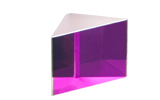 |
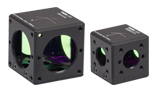 |
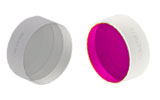 |
| Laser Line Mirrors, 1064 nm, 532 nm, 355 nm, 266 nm |
Right-Angle Prism Mirrors, 1064 nm, 532 nm |
Cage Cube-Mounted Prism Mirrors, 1064 nm, 532 nm |
Low GDD Ultrafast Mirrors, 1064 nm or 532 nm |
| Beamsplitters | Objectives | ||
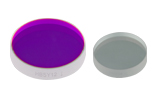 |
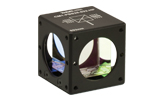 |
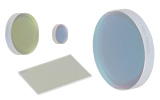 |
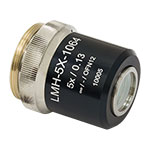 |
| Harmonic Beamsplitters, 1064 nm, 532 nm, 355 nm, 266 nm |
High-Power Polarizing Beamsplitter Cubes, 1064 nm, 532 nm: Unmounted or Mounted | Non-Polarizing Plate Beamsplitters, 1064 nm, 532 nm | High Power Focusing Objectives, 1064 nm, 532 nm |
| Lenses | Filters | ||
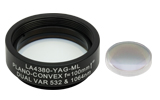 |
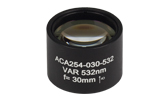 |
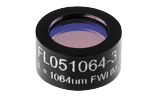 |
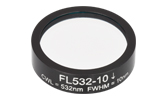 |
| UVFS Plano-Convex Lenses: 532 nm/1064 nm: Unmounted or Mounted 532 nm: Unmounted 1064 nm: Unmounted |
Air-Spaced Doublets, 1064 nm, 532 nm |
Laser Line Filters, 1064 nm: Standard or Premium |
Laser Line Filters, 532 nm: Standard or Premium |

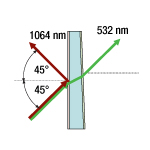
Click to Enlarge
These harmonic beamsplitters reflect 1064 nm light.
| Item # | Diameter | Thickness | Beamsplitter Coating | AR V-Coating | AOIa | Damage Thresholdb |
|---|---|---|---|---|---|---|
| HBSY051 | 1/2" | 3.0 mm (0.12") | Reflectance >99% at 1064 nm Transmission >95% at 532 nm |
Reflectance <0.5% at 532 nm |
45° | 250 W/cm (532 nm, Ø0.684 mm) 5 J/cm2 (532 nm, Ø0.279 mm, 10 ns, 10 Hz) 5 J/cm2 (1064 nm, Ø0.31 mm, 10 ns, 10 Hz) |
| HBSY11 | 1" | 5.0 mm (0.20") | ||||
| HBSY21 | 2" | 8.0 mm (0.31") |

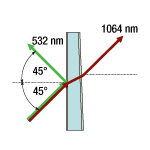
Click to Enlarge
These harmonic beamsplitters reflect 532 nm light.
| Item # | Diameter | Thickness | Beamsplitter Coating | AR V-Coating | AOIa | Damage Thresholdb |
|---|---|---|---|---|---|---|
| HBSY052 | 1/2" | 3.0 mm (0.12") | Reflectance >99% at 532 nm Transmission >95% at 1064 nm |
Reflectance <0.5% at 1064 nm |
45° | 250 W/cm (532 nm, Ø0.684 mm) 7.5 J/cm2 (532 nm, Ø0.279 mm, 10 ns, 10 Hz) 7.5 J/cm2 (1064 nm, Ø0.31 mm, 10 ns, 10 Hz) |
| HBSY12 | 1" | 5.0 mm (0.20") | ||||
| HBSY22 | 2" | 8.0 mm (0.31") |

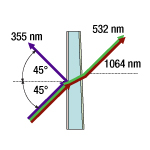
Click to Enlarge
These harmonic beamsplitters reflect 355 nm light.
| Item # | Diameter | Thickness | Beamsplitter Coating | AR V-Coating | AOIa | Damage Thresholdb |
|---|---|---|---|---|---|---|
| HBSY053 | 1/2" | 3.0 mm (0.12") | Reflectance: >99% at 355 nm Transmission: >95% at 532 nm and 1064 nm |
Dual V-Coat: Reflectance <0.5% at 532 nm and 1064 nm |
45° | 250 W/cm (532 nm, Ø0.684 mm) 2 J/cm2 (355 nm, Ø0.384 mm, 10 ns, 10 Hz) 5 J/cm2 (532 nm, Ø0.430 mm, 10 ns, 10 Hz) 10 J/cm2 (1064 nm, Ø0.644 mm, 10 ns, 10 Hz) |
| HBSY13 | 1" | 5.0 mm (0.20") | ||||
| HBSY23 | 2" | 8.0 mm (0.31") |

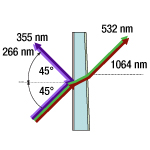
Click to Enlarge
These harmonic beamsplitters reflect 266 nm and 355 nm light.
| Item # | Diameter | Thickness | Beamsplitter Coating | AR V-Coating | AOIa | Damage Thresholdb |
|---|---|---|---|---|---|---|
| HBSY0534 | 1/2" | 3.0 mm (0.12") | Reflectance: >90% at 266 nm >99% at 355 nm Transmission: >95% at 532 nm and 1064 nm |
Dual V-Coat: Reflectance <0.5% at 532 nm and 1064 nm |
45° | 250 W/cm (532 nm, Ø0.684 mm) 0.5 J/cm2 (266 nm, Ø0.237 mm, 10 ns, 10 Hz) 2 J/cm2 (355 nm, Ø0.345 mm, 10 ns, 10 Hz) 5 J/cm2 (532 nm, Ø0.399 mm, 10 ns, 10 Hz) 7.5 J/cm2 (1064 nm, Ø0.475 mm, 10 ns, 10 Hz) |
| HBSY134 | 1" | 5.0 mm (0.20") | ||||
| HBSY234 | 2" | 8.0 mm (0.31") |
 Products Home
Products Home















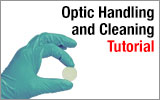
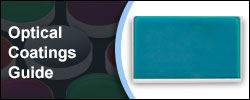

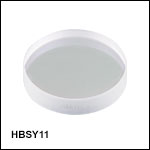
 Zoom
Zoom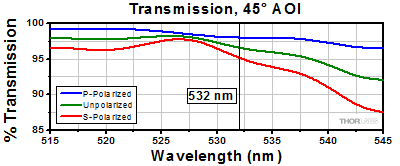
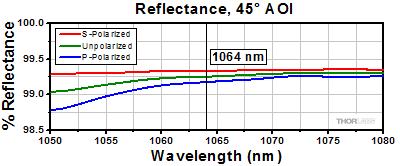
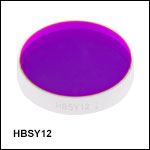
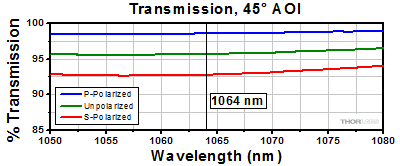
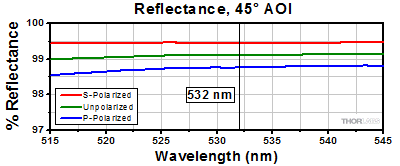
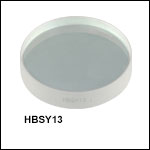
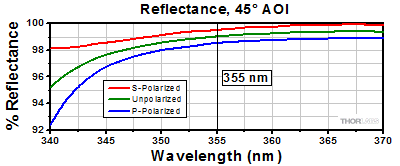
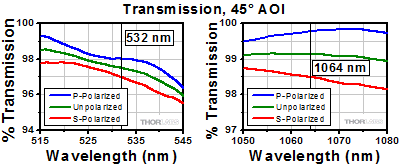
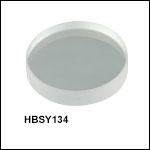
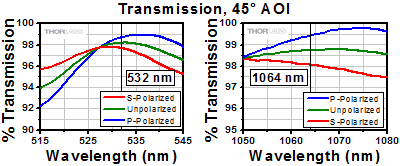
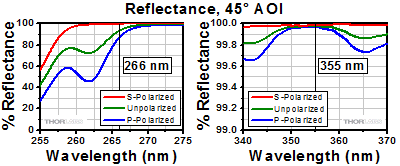
 Harmonic Beamsplitters for Nd:YAG Lasers
Harmonic Beamsplitters for Nd:YAG Lasers